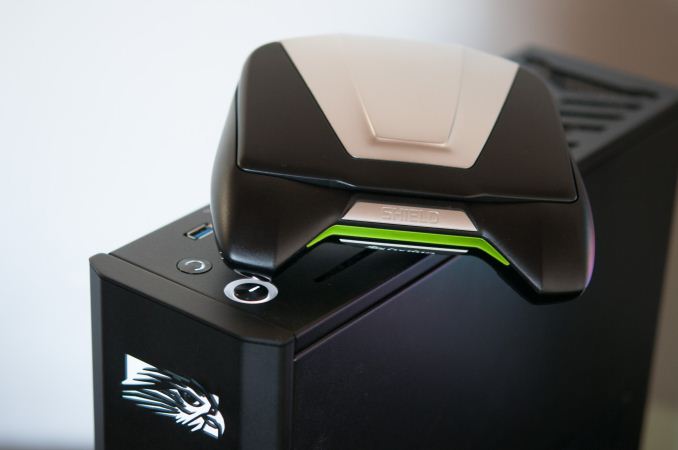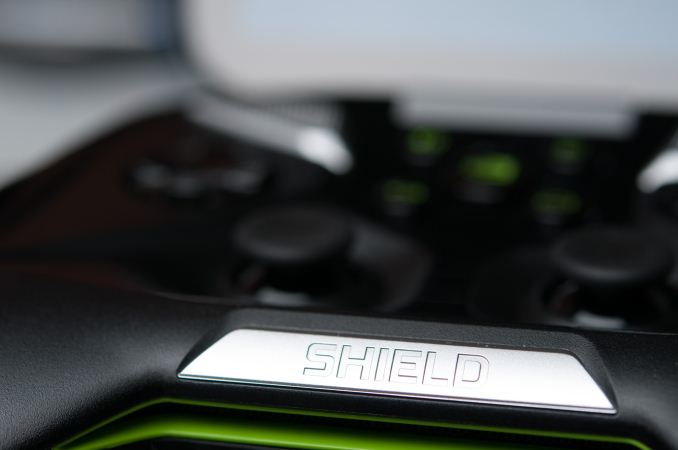NVIDIA Shield Review: At the Crossroads of PC and Mobile Gaming
by Brian Klug on July 31, 2013 12:14 AM ESTI enjoyed the time I spent with NVIDIA Shield. While it isn't perfect, for NVIDIA's first consumer electronic mobile device, it's an amazingly well put together piece of kit. Build quality is so good I told Anand that I wanted to try running it over with my car. I expected NVIDIA to fumble the controller side of the handheld gaming experience, and quite honestly with Shield I have nothing to complain about. The buttons are all tactile and fluid, the analog sticks are great, and the ergonomics leave me without anything to complain about. I remember being worried about weight and balance after seeing Shield and hearing about that the 28.8 watt-hour battery inside, but the shipping device turns all of that mass into feeling like quality rather than a big burden. The one feedback point is what I already gave NVIDIA the first time seeing Shield in person – it needs a bigger 5.5-inch display and 1080p, just buy the LG Display panel used in the LG Optimus G Pro, it's phenomenal. If a smartphone can include that size display, a portable handheld gaming console of this caliber absolutely positively needs it, and that will also help viewing PC gaming content streamed over to Shield. I also strongly believe Shield needs at least a front facing camera, that can't possibly add to the BOM too much.
Is NVIDIA Shield fun to use? It absolutely positively is. Android is still however really nascent as a gaming platform, and I wish that Google had given Shield some sort of extra special status or inclusion in the Android 4.3 love with Google Play Games and Shield as the launch vehicle. Instead it feels like NVIDIA was left to carry Shield on its own here, and that's not their fault, I just wish Google would've put two and two together, maybe a Google Play edition Shield even though it's already running stock Android 4.2.1? The games on Android are fun, there just need to be more of them, and the ones that exist need to of a higher caliber to really sell me. Of course there's always the chicken and egg argument – good Android gaming hardware really wasn't available until recently with set top consoles like Ouya or Android-running HDMI dongles, or of course the handheld format that Shield is. I enjoy playing the titles there are, there's just not quite a killer title you can point to yet.
That's where the PC gaming part comes in, and thank goodness for it. NVIDIA's execution is arguably better than the beta tag implies, with minimal hitching during streaming, impressively low latency, and good support for a number of titles that they've promised will grow. NVIDIA's real strength is on the desktop, and this is the most logical way to leverage it, even if Tegra 4 really becomes something of a thin client in that model. I spent a lot of time enjoying Borderlands 2 from places in my house that are a lot more inviting than the task chair and Ikea desk I sit at all day.
The Tegra 4 part of the story is impressive. Performance on the device is incredibly smooth, I thought I had seen the smoothest possible experience with the latest and greatest quad core SoCs in smartphones, Tegra 4 in this form factor is something to behold. There are parts of some apps I never knew could go so fast. I said in the Nexus 7 review that I wished whatever happened to Tegra 4 that delayed it hadn't, so we could see it in more devices. Shield was a big part of what made me feel that way, especially after seeing and using it in the flesh.
Shield is an impressive product. It's solid, performant, and maybe Android gaming isn't really there yet, but what it does leave me wanting is for NVIDIA to make me a phone.












134 Comments
View All Comments
DesktopMan - Wednesday, July 31, 2013 - link
Do you really need 1080p in a gaming device at this size? I'd prefer not to gimp performance. I agree that it should have been larger though, since there is space for it.Cohaagen - Wednesday, July 31, 2013 - link
I agree. I'm even happy with the 960x544 resolution of the PS Vita, so I have no problem with the 1280x720 resolution for the same screen size.JNo - Wednesday, July 31, 2013 - link
I agree. I'm amazed Brian is still gunning for 1080p. I can't imagine it would stream well at all wirelessly, especially games where laglass performance is a deal breaker. Most people can't get 1080p movies to stream over wireless N without significant issues.And it would shove the cost up significantly on what is already a non-impulse purchase.
Sorry Brian, obviously 1080 would be beautiful but it has to work and make economic sense. I'm really surprised you don't/didn't see this. Not trying to sound rude because I really love your writing.
nathanddrews - Wednesday, July 31, 2013 - link
Getting 1080p 1:1 Blu-ray (48Mbps) to stream over N is difficult without excellent conditions, but something compressed down to a Netflix-sh 8-10Mbit stream with 5.1 audio is more than realistic, even over G. Double the rate to reduce artifacts and you're golden.Sertis - Wednesday, July 31, 2013 - link
Most PC games don't scale up their fonts and fine details for higher PPI screens. If you can't see the pixels at a comfortable playing distance, you probably can't read the 12 point text. 1080p on a 7" screen might work, but that's pushing it.damianrobertjones - Wednesday, July 31, 2013 - link
"5-inch 1280x720 "Retinal" Display"Retinal display? Is that a 'Retina display' but not quite?
A5 - Wednesday, July 31, 2013 - link
"Retina Display" is an Apple trademark, iirc.jjj - Wednesday, July 31, 2013 - link
Interesting review , i don't think it will sell ,the hardware seems nice but the concept is problematic.Maybe for this one you should have included some loading time tests, the NAND perf doesn't seem all that good and made me wonder how much it impacts loading times.
Hope you guys will have a T4 tablet review soon, the Toshibas and the HP are in retail.
R3MF - Wednesday, July 31, 2013 - link
"I said in the Nexus 7 review that I wished whatever happened to Tegra 4 that delayed it hadn't, so we could see it in more devices."I glad Tegra couldn't be included in the Nexus7 update, that would have meant no OpenGL ES 3.0 and no OpenCL.
Arbee - Wednesday, July 31, 2013 - link
This thing, far more than the CPU-gimped Ouya, is the ultimate emulation machine. It's one of the first ARM devices with enough CPU grunt to do some really impressive things in that space, and Nvidia isn't blind to that market; they've been seeding beta units to emulation programmers. There's a new version of MAME4Droid with explicit support for it out already, for instance.